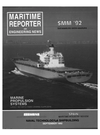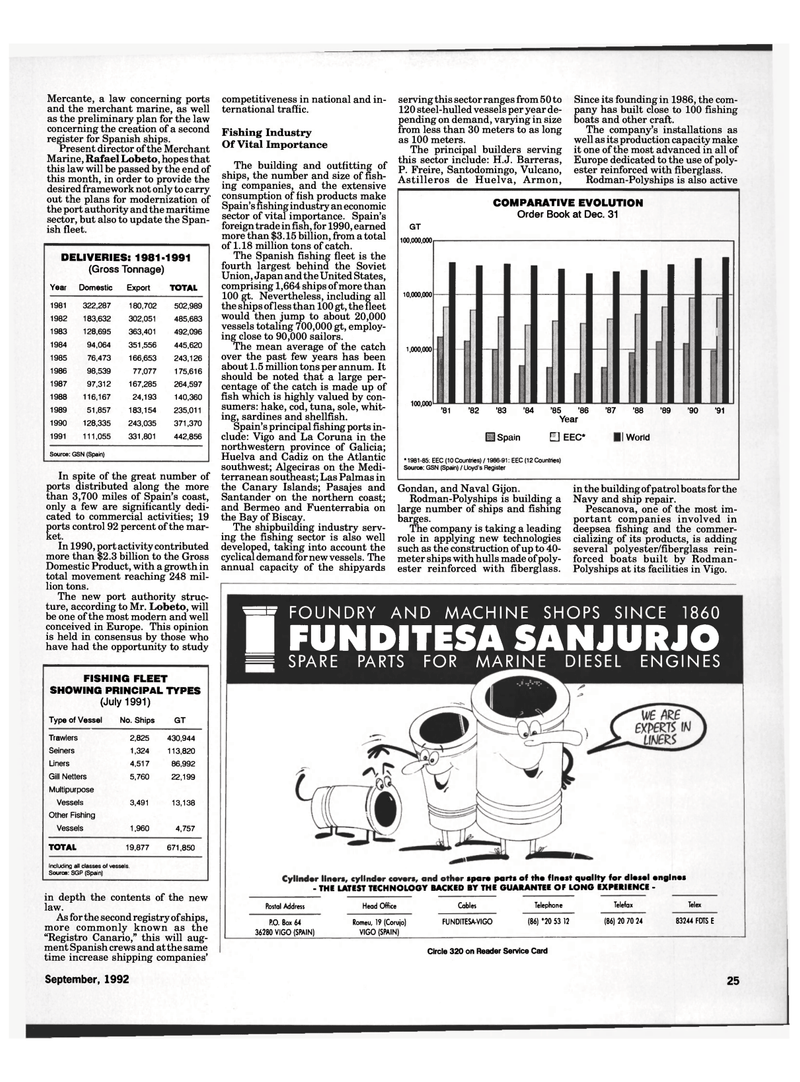
Page 23: of Maritime Reporter Magazine (September 1992)
Read this page in Pdf, Flash or Html5 edition of September 1992 Maritime Reporter Magazine
Mercante, a law concerning ports and the merchant marine, as well as the preliminary plan for the law concerning the creation of a second register for Spanish ships.
Present director of the Merchant
Marine, Rafael Lobeto, hopes that this law will be passed by the end of this month, in order to provide the desired framework not only to carry out the plans for modernization of the port authority and the maritime sector, but also to update the Span- ish fleet.
DELIVERIES: 1981-1991 (Gross Tonnage)
Year Domestic Export TOTAL 1981 322,287 180,702 502,989 1982 183,632 302,051 485,683 1983 128,695 363,401 492,096 1984 94,064 351,556 445,620 1985 76,473 166,653 243,126 1986 98,539 77,077 175,616 1987 97,312 167,285 264,597 1988 116,167 24,193 140,360 1989 51,857 183,154 235,011 1990 128,335 243,035 371,370 1991 111,055 331,801 442,856
Source: GSN (Spain)
In spite of the great number of ports distributed along the more than 3,700 miles of Spain's coast, only a few are significantly dedi- cated to commercial activities; 19 ports control 92 percent of the mar- ket.
In 1990, port activity contributed more than $2.3 billion to the Gross
Domestic Product, with a growth in total movement reaching 248 mil- lion tons.
The new port authority struc- ture, according to Mr. Lobeto, will be one of the most modern and well conceived in Europe. This opinion is held in consensus by those who have had the opportunity to study in depth the contents of the new law.
As for the second registry of ships, more commonly known as the "Registro Canario," this will aug- ment Spanish crews and at the same time increase shipping companies' competitiveness in national and in- ternational traffic.
Fishing Industry
Of Vital Importance
The building and outfitting of ships, the number and size of fish- ing companies, and the extensive consumption of fish products make
Spain's fishing industry an economic sector of vital importance. Spain's foreign trade in fish, for 1990, earned more than $3.15 billion, from a total of 1.18 million tons of catch.
The Spanish fishing fleet is the fourth largest behind the Soviet
Union, Japan and the United States, comprising 1,664 ships of more than 100 gt. Nevertheless, including all the ships of less than 100 gt, the fleet would then jump to about 20,000 vessels totaling 700,000 gt, employ- ing close to 90,000 sailors.
The mean average of the catch over the past few years has been about 1.5 million tons per annum. It should be noted that a large per- centage of the catch is made up of fish which is highly valued by con- sumers: hake, cod, tuna, sole, whit- ing, sardines and shellfish.
Spain's principal fishing ports in- clude: Vigo and La Coruna in the northwestern province of Galicia;
Huelva and Cadiz on the Atlantic southwest; Algeciras on the Medi- terranean southeast; Las Palmas in the Canary Islands; Pasajes and
Santander on the northern coast; and Bermeo and Fuenterrabia on the Bay of Biscay.
The shipbuilding industry serv- ing the fishing sector is also well developed, taking into account the cyclical demand for new vessels. The annual capacity of the shipyards serving this sector ranges from 50 to 120 steel-hulled vessels per year de- pending on demand, varying in size from less than 30 meters to as long as 100 meters.
The principal builders serving this sector include: H.J. Barreras,
P. Freire, Santodomingo, Vulcano,
Astilleros de Huelva, Armon,
Since its founding in 1986, the com- pany has built close to 100 fishing boats and other craft.
The company's installations as well as its production capacity make it one of the most advanced in all of
Europe dedicated to the use of poly- ester reinforced with fiberglass.
Rodman-Polyships is also active
FISHING FLEET
SHOWING PRINCIPAL TYPES (July 1991)
Type of Vessel No. Ships GT
Trawlers 2,825 430,944
Seiners 1,324 113,820
Liners 4,517 86,992
Gill Netters 5,760 22,199
Multipurpose
Vessels 3,491 13,138
Other Fishing
Vessels 1,960 4,757
TOTAL 19,877 671,850
Including all classe s of vessels.
Source: SGP (Spain)
COMPARATIVE EVOLUTION
Order Book at Dec. 31
GT 100,000,000 10,000,000 1,000,000 100,000 '81 '82 '83 '84 '85 '86 '87 '88 '89 '90 '91
Year • Spain • EEC* I World •1981-85: EEC (10 Countries) /1986-91: EEC (12 Countries)
Source: GSN (Spain) / Lloyd's Register
Gondan, and Naval Gijon.
Rodman-Polyships is building a large number of ships and fishing barges.
The company is taking a leading role in applying new technologies such as the construction of up to 40- meter ships with hulls made of poly- ester reinforced with fiberglass. in the building of patrol boats for the
Navy and ship repair.
Pescanova, one of the most im- portant companies involved in deepsea fishing and the commer- cializing of its products, is adding several polyester/fiberglass rein- forced boats built by Rodman-
Polyships at its facilities in Vigo. «f FOUNDRY AND MACHINE SHOPS SINCE 1860 | FUNDITESA SANJURJO = SPARE PARTS FOR MARINE DIESEL ENGINES er liners, cylinder covers, and other spare parts of the finest quality for diesel engines - THE LATEST TECHNOLOGY BACKED BY THE GUARANTEE OF LONG EXPERIENCE -
Postal Address Head Office Cables
P.O. Box 64 36280 VIGO (SPAIN)
Romeu, 19 (Corujo)
VIGO (SPAIN)
FUNDITESA-VIGO
Telephone (86) '20 53 12
Telefax Telex (86) 20 70 24 83244 FDTS E
Circle 320 on Reader Service Card
September, 1992 25

 22
22

 24
24
